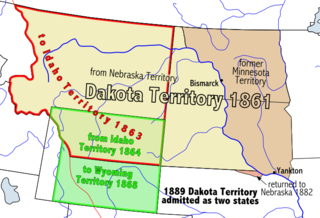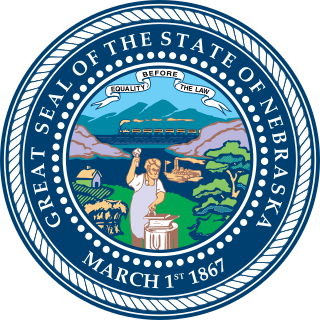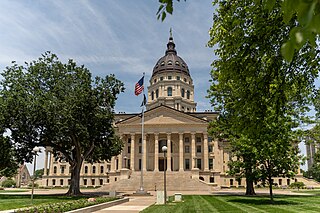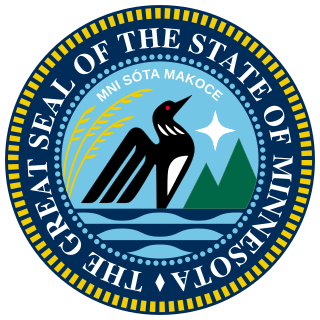
The Territory of Dakota was an organized incorporated territory of the United States that existed from March 2, 1861, until November 2, 1889, when the final extent of the reduced territory was split and admitted to the Union as the states of North and South Dakota.

The flag of Kansas was adopted in 1927. The elements of the state flag include the Kansas state seal and a sunflower. This original design was modified in 1961 to add the name of the state at the bottom of the flag.
Per aspera ad astra is a Latin phrase meaning "through hardships to the stars" and is the motto of many organizations.

John James Ingalls was an American Republican politician who served as a United States senator from Kansas. Ingalls is credited with suggesting the state motto and designing the state seal.

The Great Seal of the State of North Dakota is the official seal of the U.S. state of North Dakota.

The following is an alphabetical list of articles related to the U.S. state of Kansas.
Ad astra is a Latin phrase meaning "to the stars". The phrase has origins with Virgil, who wrote in his Aeneid: "sic itur ad astra" and "opta ardua pennis astra sequi". Another origin is Seneca the Younger, who wrote in Hercules: "non est ad astra mollis e terris via".

The Great Seal of the State of Iowa was created in 1847 and depicts a citizen soldier standing in a wheat field surrounded by symbols including farming, mining, and transportation with the Mississippi River in the background. An eagle overhead bears the state motto.

The Great Seal of the State of Florida is used to represent the government of the state of Florida, and for various official purposes, such as to seal official documents and legislation. It is commonly used on state government buildings, vehicles, and other effects of the state government. It also appears on the state flag of Florida. The University of Florida was granted the right to use the seal to represent the university.

The Great Seal of the State of Nebraska was adopted by the Nebraska legislature on June 15, 1867. It depicts a blacksmith working at an anvil along with various other symbols related to Nebraska during the early days of its statehood.

The Great Seal of the State of Nevada is derived from the Seal of the Territory of Nevada. As Nevada prepared for statehood in 1864, its Constitutional Convention began to formalize the features of the state's official seal. Nevada was admitted as a state on October 31, 1864 by proclamation of President Abraham Lincoln. On February 24, 1866, the motto "Volens et Potens" was replaced by "All for Our Country". The design of the seal was formalized, and Nevada's mineral resources are featured with a silver miner and his team moving a cartload of ore from a mountain in the foreground. A quartz mill stands before another mountain. Transportation and communication are symbolized by a train steaming across the background, with telegraph poles spanning the distance. Agriculture is represented by a sheaf of wheat, a sickle, and a plow in the foreground. Nevada's natural environment is symbolized by a brilliant sun rising over snow-capped peaks. The inner circle of the seal carries the motto "All for Our Country", and Nevada's entry into the Union as the 36th state is shown with 36 stars completing the inner ring. The perimeter of the seal proclaims "The Great Seal of the State of Nevada". Mark Twain was said to have convinced the designer to make the two trails of smoke blow in opposite directions as a prank, which was later rectified when the mistake was realized.

The Great Seal of the State of Ohio is the official insignia of the U.S. state of Ohio. All governmental offices, agencies, and courts in Ohio use variations of the state seal. Its primary feature is a circular coat of arms that depicts a sunrise in Chillicothe, Ohio's first capital, along with symbols of the state's origins. The seal sometimes appears with the state motto, "With God, All Things Are Possible".

The Seal of the State of Oregon is the official seal of the U.S. state of Oregon. It was designed by Harvey Gordon in 1857, two years before Oregon was admitted to the Union. The seal was preceded by the Salmon Seal of the Provisional Government and the Seal of the Oregon Territory. The state seal is mandated by Article VI of the Oregon Constitution.

The Kansas State Capitol, known also as the Kansas Statehouse, is the building housing the executive and legislative branches of government for the U.S. state of Kansas. Located in the city of Topeka, which has served as the capital of Kansas since the territory became a state in 1861, the building is the second to serve as the Kansas Capitol. During the territorial period (1854–1861), an earlier capitol building was begun but not completed in Lecompton, Kansas, and smaller structures in Lecompton and Topeka were where the territorial legislatures met.

Per ardua ad astra is a Latin phrase meaning "through adversity to the stars" or "through struggle to the stars" that is the official motto of the Royal Air Force and other Commonwealth air forces such as the Royal Australian Air Force and Royal New Zealand Air Force, as well as the Royal Indian Air Force until 1947. The Royal Canadian Air Force used it until 1968, when it adopted the motto sic itur ad astra, a similar phrase meaning "such is the pathway to the stars". It dates from 1912, when it was adopted by the newly formed Royal Flying Corps.
Ad Astra Per Aspera is an American, Lawrence, Kansas-based indie rock and punk and tropical band, formed in 2001 and currently releasing records through Sonic Unyon Records and Love Garden Records. Their experimental and eclectic noise rock sound has drawn comparisons to bands such as Sonic Youth and the Pixies.

Order of the Three Stars is the highest civilian order awarded for meritorious service to Latvia. It was established in 1924 in remembrance of the founding of Latvia. Its motto is Per aspera ad astra, meaning "Through hardships towards the stars". The Order has five ranks and three grades of medals of honour.

The Great Seal of the State of Minnesota is the state seal of the U.S. state of Minnesota. It was adopted on May 11, 2024, alongside the state flag, for Statehood Day. It features a common loon, Minnesota's state bird, wild rice, the state grain, and the North Star, representing the state's motto, and is themed around Minnesota's nature. In the inner circle is the phrase Mni Sóta Makoce, the Dakota term for "Land where the water reflects the sky," which is the origin of the state's name.

















